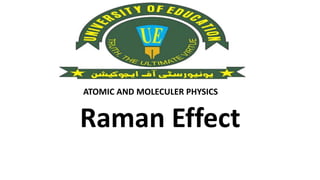
RAMAN EFFECT
- 1. ATOMIC AND MOLECULER PHYSICS Raman Effect
- 2. Raman Effect or Raman Scattering Feynman diagram of scattering between two electrons by emission of a virtual photon. Raman scattering or the Raman effect is the inelastic scattering of photons by matter, meaning that there is an exchange of energy and a change in the light's direction. Typically, this involves vibrational energy being gained by a molecule as incident photons from a visible laser are shifted to lower energy. This is called normal Stokes Raman scattering.
- 3. Many other variants of Raman spectroscopy allow rotational energy to be examined and electronic energy levels may be examined if an X ray source is used in addition to other possibilities. Light has a certain probability of being scattered by a material. When photons are scattered, most of them are elastically scattered (Rayleigh Scattering), such that the scattered photons have the same energy (frequency, wavelength and colour) as the incident photons but different direction. Experimental Modern Raman spectroscopy nearly always involves the use of lasers as an exciting light source. Because lasers were not available until more than three decades after the discovery of the effect, Raman and Krishnan used a mercury lamp and Photographic plates to record spectra. Early spectra took hours or even days to acquire due to weak light sources, poor sensitivity of the detectors and the weak Raman scattering cross-sections of most materials. The most common modern detectors are Charge Coupled Devices (CCDs). Photodiode Arrays and photomultiplier tubes were common prior to the adoption of CCDs.
- 4. The following focuses on the theory of normal (non-resonant, spontaneous, vibrational) Raman scattering of light by discrete molecules. X ray Raman Spectroscopy is conceptually similar but involves excitation of electronic, rather than vibrational, energy levels.
- 5. Molecular Vibrations Raman scattering generally gives information about vibrations within a molecule. In the case of gases, information about rotational energy can also be gleaned. For solids, phonon modes may also be observed. The basics of infrared absorption regarding molecular vibrations apply to Raman scattering although the selection rules are different.
- 6. Vibrational energy The energy range for vibrations is in the range of approximately 5 to 3500 cm-1. The fraction of molecules occupying a given vibrational mode at a given temperature follows a Boltzmann Distribution. A molecule can be excited to a higher vibrational mode through the direct absorption of a photon of the appropriate energy, which falls in the terahertz or infrared range. This forms that basis of infrared spectroscopy. Alternatively, an inelastic scattering process may occur which leaves the molecule in the same vibrationally excited state, this is called Stokes Raman scattering. Conceptually similar effects can be caused by neutrons or electrons rather than light. An increase in photon energy which leaves the molecule in a lower vibrational energy state is called anti-Stokes scattering.
- 7. Raman Scattering Raman scattering is conceptualized as involving a virtual electronic energy level which corresponds to the energy of the exciting laser photons. Absorption of a photon excites the molecule to the imaginary state and re-emission leads to Raman or Rayleigh scattering. In all three cases the final state has the same electronic energy as the starting state but is higher in vibrational energy in the case of Stokes Raman scattering, lower in the case of anti-Stokes Raman scattering or the same in the case of Rayleigh scattering.
- 8. The different possibilities of light scattering: Rayleigh scattering (no exchange of energy: incident and scattered photons have the same energy), Stokes Raman scattering (atom or molecule absorbs energy: scattered photon has less energy than the incident photon) and anti- Stokes Raman scattering (atom or molecule loses energy: scattered photon has more energy than the incident photon) Applications Raman spectroscopy employs the Raman effect for substances analysis. The spectrum of the Raman- scattered light depends on the molecular constituents present and their state, allowing the spectrum to be used for material identification and analysis. Raman spectroscopy is used to analyse a wide range of materials, including gases, liquids, and solids. Highly complex materials such as biological organisms and human tissue can also be analysed by Raman spectroscopy. For solid materials, Raman scattering is used as a tool to detect high-frequency phonon and magnon excitations. Raman lidar is used in atmospheric physics to measure the atmospheric extinction coefficient and the water vapour vertical distribution. Stimulated Raman transitions are also widely used for manipulating a trapped ion's energy levels, and thus basis qubit states. Raman spectroscopy can be used to determine the force constant and bond length for molecules that do not have an infrared absorption spectrum.